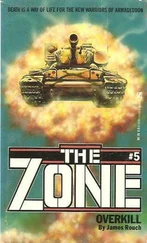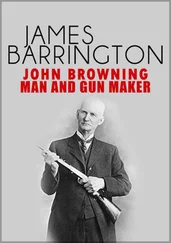‘Why have they done that?’ Richter asked. ‘Just to be bloody awkward?’
Dewar glanced briefly towards the rear of the trailer. ‘If this was a French device, I’d agree with you,’ he said. ‘French engineering makes a point of complicating everything for no readily apparent reason. In this case, though, I think it’s just to ensure that the correct bolts are used. The pressures generated within a nuclear weapon at the moment of detonation boggle the mind, and it is essential that the trigger assembly remains in place for the period intended by the designer. These bolts have been specially made and have enormous tensile strength.’
He selected a ratchet handle from a socket set and attached a six-inch extension to it. Then he fitted an Allen bolt key to the end and snapped it into the head of one of the bolts. ‘You’ll find that they’ll take some shifting,’ he said. ‘We calculated the torque setting used at about three hundred foot-pounds. We removed all these earlier, so there’s no problem.’ Working quickly, he undid and removed five of the six bolts, then steadied the cylinder with one hand while he removed the last one. Then he put both hands around the cylinder and eased it slowly out of the bomb casing.
‘It’s quite heavy,’ he said, ‘but the important thing is to avoid it touching the sides of the casing as you remove it. If you do that, you could earth the cylinder and that might activate the trigger. I’m not saying it would, but it could, and I wouldn’t want to try it.’
‘Nor would I, thanks. And then?’
‘You’re almost there. With the trigger out of the sphere, put it on the floor and cut the four leads attached to it.’
Richter was puzzled. ‘Won’t that fire the trigger?’
‘Yes, of course. Oh – I see what you mean. This isn’t an explosive trigger; it’s mechanical.’ He held it up so that Richter could see it, and pointed at the sides. ‘These four bolts are recessed at present,’ he said. ‘When the trigger fires they will extend simultaneously and make contact with four electrically active panels on the inside of the hole in the bomb casing. That will complete the electrical circuit which triggers the explosive charge that actually fires the weapon. It’s an unusual system,’ he mused, ‘and there are some odd features in the design of the weapon itself.’
‘You might,’ Richter said, ‘get a chance to look at it more closely later on. Anything else I should know?’
‘Only to keep your fingers out of the way of the four bolts when you cut the wires attached to the trigger,’ he said, ‘but otherwise, that’s it.’
‘What about radiation from the weapon?’ Richter asked. ‘Once the trigger’s been removed, I mean.’
‘We’ve measured it, and it’s not significant,’ Dewar replied. ‘The fissionable material is obviously shielded within the bomb casing itself.’
‘OK, I’m happy with the disarming instructions, but please give me your mobile phone number now, and leave the mobile switched on for the next twenty-four hours. That’s just in case I meet any other problems down in Gibraltar.’
‘Of course,’ Dewar said. He wrote a number on a slip of paper and gave it to Richter.
‘Oh, one last thing,’ Richter said, ‘can I borrow the socket set and your pliers?’
Reims airport, France
The Alouette dropped out of the darkening sky and settled on to a concrete hardstanding to the north of the main runway at Reims airport. The ground marshaller dropped his light wands into the ‘park’ position – in a cross below his waist – and the pilot commenced the shutdown sequence. As the clattering of the rotors died away, Richter unstrapped and climbed out. A figure standing beside the marshaller walked over to him. ‘Mr Beatty?’
‘Yes.’
‘Squadron Leader Reilly, 9 Squadron. I believe I’m your driver.’ They walked over to a small building adjacent to a hangar and entered. Inside, another RAF officer was waiting. ‘Flight Lieutenant Peter Marnane, my navigator.’
‘Beatty,’ Richter said.
Reilly pointed to a set of flying clothing draped over a chair. ‘We were given your measurements, so hopefully that lot should fit,’ he said. ‘While you’re dressing, a few questions.’
Richter took off his jacket, and there was a noticeable pause as the RAF officers saw the Smith and Wesson in the shoulder rig. Richter took it off and undid his tie. ‘Fire away.’
‘Have you flown in a fast jet before?’ Reilly asked.
‘Yes,’ Richter said. ‘I’m ex-Navy and a qualified Sea Harrier pilot, and I’ve also flown Jet Provosts, Hawks, Jaguars and a MiG–29 Fulcrum.’
‘Jesus Christ,’ said Marnane.
Richter grinned at him. ‘I was joking about the Fulcrum,’ he said. Richter pulled on the long underwear and long-sleeve pullover, then climbed into the g-suit, designed to keep the supply of blood to the brain as constant as possible during high-energy manoeuvres, while Reilly went through a pre-flight safety briefing. The life-saving jacket was an unusual design with sleeves to accommodate the arm restraints Tornado crews wear to protect them if they have to eject at high speeds. Finally he put on the helmet and gloves.
‘Before we go out to the Tornado,’ Reilly said, ‘I have to remind you that it is a two-crewman aircraft, and isn’t designed to accommodate a pilot plus a passenger. I know you’re a qualified pilot, but not on the Tornado, and there will be some operations that you will have to carry out for me. Obviously I will talk you through them, but Peter has prepared a kind of idiot’s guide to the switches and controls for you.’
‘OK.’
‘Finally, I am aware that you carry substantial authority, otherwise I’d be tucked up cosily at home in Lincolnshire instead of standing in an unventilated hut in the middle of France. But I must emphasize that I am the aircraft captain, and all decisions relating to the safety of the aircraft are mine. You must obey any and all orders I give without question, unless of course you don’t understand them.’
‘Agreed,’ Richter said.
Reilly smiled. ‘And if I say “eject”, and you say “pardon”—’
‘I know,’ Richter finished it for him, ‘I’ll be talking to myself.’
The Panavia Tornado GR–1 was parked on the adjacent hardstanding. Marnane clambered up the steps positioned against the port side of the aircraft and leant into the rear cockpit. ‘He’s switching on the Inertial Navigation System and warming up the radar,’ Reilly said, then walked round the aircraft carrying out external pre-flight checks.
Marnane helped Richter get into the rear seat, which was easier than he had expected. Strapping into the Martin-Baker Mark 10 ejection seat was slightly non-standard. First, the personal survival pack, which actually forms the seat cushion, was attached to a lanyard on the life-saving jacket, and then Marnane fastened the negative-g, lap and shoulder straps. Then he attached the leg restraints which hold the legs firmly against the seat in the event of an ejection and fastened the arm restraints to the life-saving jacket. Finally, Richter put on the helmet, plugged the communications lead into the intercom system and attached the oxygen mask.
Reilly was already sitting in the front cockpit, and as soon as Marnane tapped him on the shoulder and gave him a thumbs-up sign, he called on the intercom. ‘Ready, Mr Beatty?’
‘Ready,’ Richter said.
‘Your mobile is switched off and your weapon and other equipment are stowed?’
‘Yes,’ Richter replied. ‘They’re in the storage compartment.’
‘OK. Closing the canopy.’ Richter heard the whine as the electric motor drove the canopy down into the closed position, and Reilly talked briefly – and in French, Richter noted – to the ground crew, who were linked to the aircraft’s intercom, and started the starboard engine, then the port. ‘You’ll feel some bumps and shudders now,’ Reilly said on the intercom. ‘I’m running the BITE program.’
Читать дальше












